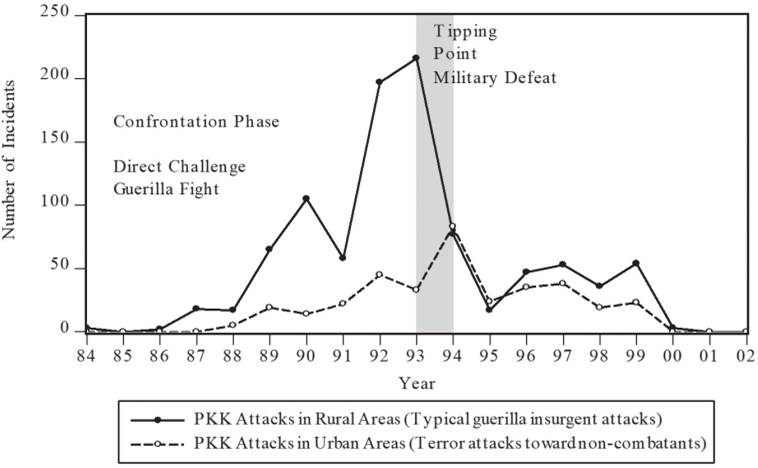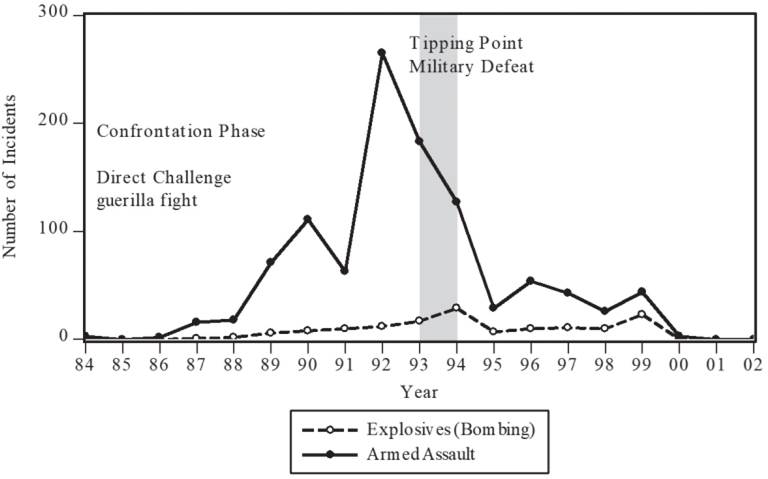Introduction
Turkeys fight against the Kurdistan Workers’ Party (PKK; Partiya Karkeren Kurdistane) officially began in 1984 and has been ongoing for almost 35 years. It has resulted in approximately 50,000 deaths, among them nearly 6,146 civilians and 7,473 security force members (Table 1).1
Table 1. Casualties due to the PKK conflict between 1984 and 2018
Source: Created by the authors.
Despite the immense losses on both sides, they have remained trapped in a never-ending spiral of violence (Ünal, 2016a; 2016b).
Turkey has implemented different countermeasures throughout its struggle against the PKK, ranging from enemy-centric -often repressive and iron-fisted- to population-centric approaches -accommodative and conciliatory means with less emphasis on using armed forces (Miron, 2019a; Ünal, 2012a; 2016c). As a result of the Turkish Armed Forces (TAF) military campaign, 32,562 PKK militants were neutralized, 1,566 were injured, 8,162 were captured, and some 7,146 surrendered (Table 2).2
Table 2. Killed, injured, captured, and surrendered PKK members (1984-2018)
Source: Created by the authors.
However, the PKK could not be fully eradicated; it has demonstrated resilience despite the immense losses (Gürcan & Ünal, 2018). It has managed to not only survive and adapt-changing its political goals and, subsequendy, strategic approaches- but also continue posing a formidable threat to the Turkish State (Miron, 2019b; Ünal, 2016d).
For almost four decades, the conflict has undergone different stages marked by shifts in the politico-military environment and external and internal pressures. These circumstances have made both parties adjust their political objectives and their respective strategies. This strategic interaction or power game’ came to resemble the otherwise known tit-for-tat mechanism. Following many turning points and teaching moments, both parties were caught in a costly deadlock by the year 2000 (Gürcan &: Ünal, 2018). Due to this strategic interaction, the conflict has gone through different phases based on critical breaking points in its life cycle. Each evolutionary phase is marked by crucial differences in each party’s choices on all levels of the stratagem: political, grand strategic, and military strategic.
Therefore, this article aims to offer a thorough examination of the strategic interaction between the Turkish State and the PKK throughout the conflict, attempting to answer the following question: “ What strategies did both parties use at different levels, and to what extent were they aligned with the respective 'political end state(s) ?
To this end, this article is structured to reflect two-pronged analyses:
identify Turkeys and the PKK’s strategies at different levels and political objectives since the beginning of the conflict; and
analyze these strategies and their relationship with the political ends in formulating approaches to winning the fight.
In order to create a viable framework for such analysis, it draws its theoretical underpinnings from Carl von Clausewitzs (1976) On War and Colin Grays seminal works on strategic theory, namely, Strategy Bridge (2010) and Theory of Strategy (2018). Against this backdrop, this study is designed to reflect a structured process tracing to elucidate both Ankara’s and the PKK’s political ends and strategies in an interrelated fashion in each evolutionary phase. The phases to be examined are confrontation (1984-2000), transformation (2000-2009), reconciliation (2009-2015), and re-ignition (2015-Present).
To conduct the analyses, we use multiple quantitative and qualitative data. These include multiple large-scale datasets from the Turkish Government’s official database and incident-level datasets from the Global Terrorism Dataset (GTD) and the Institute for the Study of Violent Groups (ISVG). Official government datasets reflect longitudinal time series data, including official aggregate-level violent incidents and reported casualty records (in the TAF and Ministry of Interiors websites) in annual observation points, covering the period from August 1984 (the official beginning of the fight) to December 31,2016. The ISVG and GTD institutional databases covering the 1984-2016 period include incident-level time series data on violent incidents, involving PKK-initiated attacks, incident types and location (geo-spatial), and target (combatant, non-combatant, facility, infrastructure) status information. More importantly, this study examines the PKK’s main decision-making mechanisms, periodic congresses, and sporadic conferences3 to identify its internal dynamics and main drivers for devised strategies. The main themes of these assemblies have been published in pro-PKK periodicals and journals available online (e.g., pro-PKK periodical “Serxwebun”). In addition, data are used from PKK sources, such as related books, documents, and reports. These documents reveal critical information on the PKK’s perception of the geospatial contingencies, surrounding conditional dynamics, Ankara’s actions, and the PKK’s counteractions.
This study is an important contribution to the literature in the strategic and security studies field. Firstly, from a strategic studies perspective, there is no in-depth study focusing on both parties and their strategic choices throughout the conflict. Secondly, in contrast to a reductionist approach to the conflict’s historical emergence and evolution or the effectiveness of Ankara’s countermeasures -limited to the violence level and conducted through an external outlook- this study uses a broader focus on the parties’ structural dynamics of strategic choices and their relation or alignment with their political end-states. Thirdly, it explains the critical turning points resulting from parties’ strategic interaction reflected in the character and form of violence. The aim here is to better comprehend the historical evolution and the political and geographic dimensions present in Turkey and its surrounding environment at the time of writing. Lastly, and perhaps, most importantly, it focuses on the PKK’s internal dynamics identified through its main decision-making mechanisms of periodic congresses, ad-hoc conferences, and leadership statements.
To address the above research question, we first review the general theory of strategy, levels of strategy, and war and explain some common terminology used in the contemporary literature to maintain clarity. Second, we longitudinally analyze the conflicting parties’ strategies and political objectives by making a structured periodization in line with the conflicts life cycle and evolutionary phases. Finally, having created a theoretical framework as a point of departure, the importance of a strategy bridge -or a lack thereof- is shown by examining Ankara’s campaign against the PKK.
Theoretical underpinnings
In order to guide this research, in this section, we define the core terms, namely, strategy and its variations, looking at its different levels concerning the political objective. In general, strategy can be described as “[t]he direction and use made of means by chosen ways in order to achieve desired ends” (Gray, 2010, p. 18). Thus, it revolves around a set of fundamental variables, namely, ends, ways, means, and assumptions, though the last one (assumptions)4 will be omitted for clarity (Gray, 2010). Strategies are always content-specific in particular contexts, including the diplomatic, military, and similar (Gray, 2010). While the variables outlined previously remain true for each strategy, the circumstances under which it is formulated and executed assign a unique value to each named variable. This definition gives us a basic understanding of what strategy is. However, for the purpose of this study, a more refined definition is needed. The aim here is to examine strategy in the context of statecraft, which is otherwise known as grand strategy.
Let us briefly review several definitions to shed some light on what grand strategy means. The first definition of grand strategy emerged at the beginning of the 20th century. A prominent British naval historian, Sir Julian Corbett, was the first to make an explicit distinction between major strategy and minor strategy. This major strategy, or grand strategy, to use contemporary jargon, “.. .has also to deal with the whole resources of the nation for war. It is a branch of statesmanship,” he stressed (Julian 1911, p. 308). Paraphrasing, a major or grand strategy is not limited to the use of military force alone, a concept that contrasts the definitions of strategy offered a century earlier.5 Instead, the grand strategy encompasses a broad range of different tools available to the statesman. However, there is more. As the contemporary British historian Paul Kennedy puts it:
(...) the crux of grand strategy lies therefore in policy, that is, in the capacity of the nation’s leaders to bring together all of the elements, both military and nonmilitary, for the preservation and enhancement of the nation’s long-term (that is, in wartime and peacetime) best interests. (Kennedy, 1991, p. 5)
Though extensive, Kennedy’s definition conveys an important message, namely, that a grand strategy’s task is to enable a political leader to use all state resources, such as diplomatic, informational, military, and economic, to ensure the nation’s long-term interests. This definition creates vital links between grand strategy and long-term national interests in a way that implies that grand strategy should always -at least in theory- be geared towards fulfilling national objectives. Another important point this definition reveals is that grand strategy remains active during both war and peacetime (Gray, 2010). Kennedy’s idea of grand strategy closely resonates with Colin Gray’s definition: “[t]he direction and use made of any or all among the total assets of a security community in support of its policy goals as decided by politics” (Gray, 2010, p. 19). Gray’s definition is perhaps more elegant in that, building on Clausewitz’s thought, it emphasizes the role of policy6 as the primary determinant of how grand strategy unfolds in any given scenario.
Briefly returning to the ends, ways, and means formula, one can arrive at the following: policy objective is the ends'; grand strategy is the way, various tools of statecraft, including the military, are the means, in that order. While all three variables are interrelated, it should be stressed that their relationship is strictly hierarchical as far as strategic theory is concerned. Grand strategy cannot or should not operate in a vacuum. Devoid of purpose, namely, the political objective, the practice of grand strategy becomes a self-defeating exercise. Certainly, as much as a political objective sets the tone for grand strategy (Marks, 2005) and, subsequently, for all lower-tier strategies, to the same degree, grand strategy should inform the decision-maker whether or not the available tools are sufficient to achieve the desired political objectives, or in the eloquent words of Walter Russell Mead, “[g]rand strategy was about deciding what wars to fight” (Mead, 2005).
Levels of strategy and war
For this article’s purpose, the general definition of strategy is divided into two levels: grand strategy (described above) and military strategy. These two terms are sometimes used interchangeably. However, they represent different levels of stratagem and should be conceptually distinguished. Grand strategy, as noted, refers to the use of all state resources and operates at the state/governmental level. Military strategy, in contrast, is focused at a level below and solely addresses the use of military forces. Carl von Clausewitz defines (military) strategy in broad strokes as “. ..the use of engagements for the object of the war” [italics in the original] (Echevarria, 2017, p. 1-5; Gray, 2010, p. 19).
In contemporary official publications, the idea of military strategy has received a more fine-tuned definition (Yarger 2006). The US Joint Chiefs of Staff offers the following: “[t]he art and science of employing the armed forces of a nation to secure the objectives of national policy by the application of force, or the threat of force” (as cited in Jablonski 1987, p. 52). It is this latter definition that is adopted here. It should be noted that while there are levels below military strategy -operational and tactical- it is beyond this articles limits to consider them.
In much of the thinking devoted to strategy in war, there is a great conflation over the meaning of ends, ways, and means and their interrelationship. However, considering their mutual relationship is essential because the ends will always be the main determinant for which ways are to be adopted using which means. Figure 1 shows the relationship between political objective, grand strategy, and military strategy.

Source: Created by the authors.
Figure 1. Hierarchical Relationship between the main Policy (political end-state). Grand Strategy, and Military Strategy (Operations and Tactics)
Despite their symbiotic relationship, political end-state, grand strategy, and military strategy are closely interconnected; their relationship should be strictly hierarchical with a “descending ranking of relative significance” (Gray 2010, p. 20).
For instance, inferior tactical performance can be corrected by an accomplished strategy, and a bad strategy can sometimes be corrected by a skillfully crafted policy (Gray 2010). The reverse, however, can prove disastrous. That is, a poor policy -one that asks the impossible of the military instrument- can rarely be corrected by tactical brilliance on the battlefield. Similarly, a bad strategy -one that fails to align the political goal(s) with the available means- cannot, in most cases, be remedied by battlefield victories (Gray, 2009; Gray, 2010).
Lastly, it is worth stressing that the definitions of strategy’s essence (at both levels) and its subordinate role to policy are valid for all wars regardless of their character, conventional (or regular) or unconventional (or irregular) (Gray, 2010; 2018). However, the character of each individual war, the political end state sought, and available means -at least the means a protagonist can and is willing to employ- will determine which (specific) strategies are used. To use Gray’s (2009) words, “(...) military strategy should be developed and applied in the context of the development and application of strategy for the use of other, nonmilitary, assets, as and when appropriate.” (p. 82)
Having given a brief overview of what strategy is and how it is linked to both the political objectives and the bluntest instrument in the arsenal of statecraft -the military force- this article proceeds with a longitude analysis to examine the strategic interplay between the Turkish State and the PKK.
Longitudinal analysis
After a brief overview of the historical context and the preliminary phase, in this section, we analyze each evolutionary phase in relation to the political ends and grand and military strategies of both parties.
Historical context
Kurdish dissent has been a deep-rooted historical issue, dating back to the Ottoman Empire. The latest Kurdish unrest re-emerged as an ethno-nationalist identity conflict in the 1970s internal and external contextual dynamics. This reemergence was part of the so-called ‘third wave of modern terrorism’ or the new left wave’ and the new cycle of national awareness universally induced by the nation-state phenomenon of the Cold War and post-Cold War eras (Rapoport, 2004). In light of this, the PKK emerged as an idea in 1973. After its ideological mobilization, Abdullah . Öcalan officially founded the organization on November 27, 1978, in Diyarbakir-Lice province. Ocalan openly declared that Kurdistan could be founded through the armed mobilization of the Kurds. Öcalans vision for the PKK was to start a so-called guerilla war7 in 1984, in which all the Kurdish people were involved militarily in a struggle for independence (Öcalan, 1978).
Preliminary Phase (1978-1984)
Given the underlying grounds for the previous Kurdish unrests, the PKK’s political end was to establish an “Independent ‘United’ Kurdish State” comprised of Kurdish-populated territories of Turkey, Iraq, Iran, and Syria. To this end, the PKK chose a “protracted war” approach devised by a Chinese revolutionary and strategic theorist, Mao Zedong (Kocher, 2002). Mao’s influence was expressed in the PKK’s founding manifesto, entitled The Path for Revolution in Kurdistan (Öcalan, 1978), in its first Congress of 1978. In the manifesto, the PKK adopted Mao’s strategic construct, consisting of three phases: strategic defensive, strategic equilibrium, and strategic offensive (Ünal, 2012a). Following Mao’s theory, the PKK’s envisaged a revolution flowing from rural Kurdish-populated areas of southeastern Turkey to metropolitan areas (Ünal, 2012a). Ideologically, the PKK declared itself a Marxist-Leninist socialist liberation movement. By 1982, the PKK was predominantly stationed in Northern Iraq and the southeastern part of Turkey, conducting isolated attacks on the Turkish State, commencing the phase of strategic defense. However, the official declaration did not come until 1984, when the PKK launched two attacks in the Şemdinli and Eruh Districts, killing one soldier and injuring twelve other people, three of whom were civilians (Ünal, 2016c).
Phase I: Confrontation: The Decisive Phase (1984-1993/94)
The PKK continued its strategic defense until 1986. The aim was to exhaust the TAF and exploit their unpreparedness through protracted warfare. At that time, Ankara had already been experiencing political turmoil, and martial law had been underway since the coup d’état in 1980. However, the government was caught off-guard when the PKK insurgency struck. Initially, the then political leadership considered the PKK a “bunch of bandits” to be dealt with by the responsible law enforcement units, refraining from specific military action until 1987. As a result, the PKK’s initial surge was handled by the gendarmerie, which, at the time, was part of the TAF, however, serving as a law enforcement unit with jurisdiction in rural areas for maintaining public order (Ünal, 2014; 2012b).
In its 3rd Congress of October 1986, the PKK established its Peoples Liberation Army of Kurdistan ((Artêşa Rizgariya Gelé Kurdistané ARGK) as a replacement for its individual attack units of the Kurdistan Independence Unit (HRK) to advance its fight (Ünal, 2016d). After 1986, the PKK moved to strategic equilibrium, employing increased systematic violence and conducting raids on isolated army bases with convened groups of up to 600 and strived to advance throughout the key region,8 namely, southeastern and eastern Anatolia, where a Kurdistan was to be established. The aim was “out-fighting” the TAF through physical extermination (Ünal & Cafnik Uludag, 2020; Ünal, 2016c).
The initial political objective was a decisive victory against the PKK. This goal was to be achieved by denying the insurgent territorial control and ensuring its physical extermination along with contra-PKK ideology (denial of Kurdish identity, linguistic, and cultural rights until the early 1990s) (Kocher, 2012; Ünal, 2012b). In its strife for a decisive military victory, the incumbent government enacted measures at the grand strategic level designed to supplement heavy military action commencing in 1987 (explained next). First, in 1985, Ankara created the village guard system (Geçici Köy Koruculuğu or GKK), consisting of volunteer Kurdish villagers trained and armed by the TAF to defend their villages against the PKK (Gürcan, 2015a). Two years later, in 1987, the GKK system was fully consolidated. In the same year, it implemented an emergency rule in the region, followed by a forced evacuation measure (Ünal, 2012a). The latter aimed at evacuating (Kurdish) citizens from remote hamlets and villages and resettling them into larger and safer communities, thereby enabling the TAF to have heightened control of the region.
The GKK system was perhaps the biggest obstacle to the PKK’s grand strategy, which had envisaged the spread of the revolution from rural to urban areas. However, Turkey’s Kurds were heterogeneous in their social and political character. They had a highly feudal structure in which tribal leaders ruled as local elites and held political power. While some tribes supported the PKK, others did not, triggering a violent reaction from the PKK towards what it perceived to be non-compliant’ Kurds whom the insurgent sought to mobilize for its cause. As shown in Figure 2, between 1986 and 1988, GKK and Kurdish civilian casualty levels greatly surpass that of security personnel.
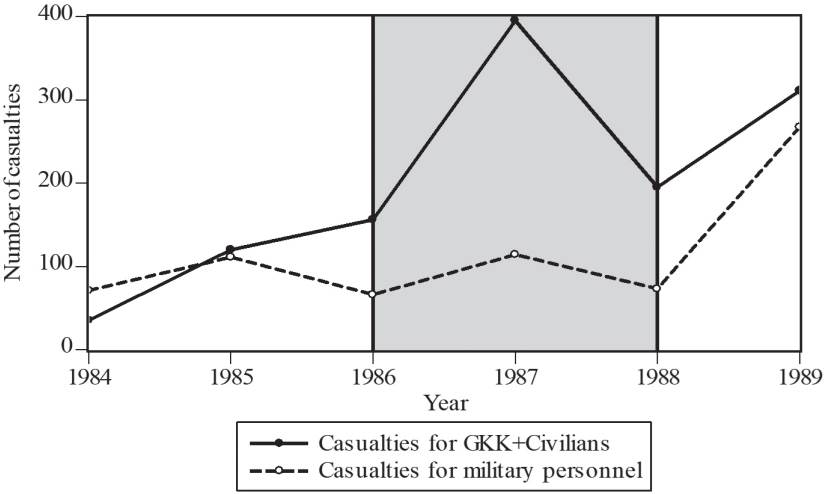
Source: Created by the authors.
Figure 2. Number of casualties for the GKK and civilians vs. military personnel
In 1987 alone, the PKK carried out 15 different attacks in the provinces of Sirnak, Mardin, and Siirt, one of which was in the village of Pinarcik. It resulted in the killing of 30 Kurdish civilians, 16 of which were children and eight were GKK members (Ünal, 2014; 2012b).
After being inactive until 1987, the TAF started to craft its military strategy, primarily designed to control the contested territory. South and Southeastern Anatolia. To this end, a large number of army bases were set up all over the region, a practice that came to be known as Zone/Area Control. The attempt to deny the PKKs control of the territory was the TAF s mirror response to the PKK’s protracted warfare. However, the scattered battalion-level army bases became easy targets for the PKK, given the advantage provided to the insurgent by the harsh terrain. Thus, the insurgents conducted numerous raids on these bases, as well as army stations, like Hakkari-Serin (nine soldiers killed in 1985), Samanli (ten in 1991), Cobanpinar (six in 1991), Taslitepe (11 in 1991), Uzumlu (15 in 1992), and Tasdelen (27 in 1992). The area control, therefore, did not yield the expected results (Ünal, 2012a).
Reflecting its resolutions from its 2nd Conference (1990) and 4th Congress (1991), the PKK strived to attrit the government in these regions during this phase.9 The PKK directly challenged and confronted the TAF, striving to drive them out (Ünal & Cafnik Uludag, 2020). Following the Maoist strategy, the PKK conducted attacks in places where the governmental control was weak, such as remote hamlets, villages, and military outposts. In other words, in this confrontation phase, the PKK sought to achieve territorial control through military victory. Thus, its military strategy was direcdy linked to its political ends, sidelining the grand strategy’s role during this phase. The organization also employed selective violence against civilian government staff as part of its “out-fighting” approach and targeted religious figures and public servants, killing 27 imams and 116 teachers (Ünal, 2012a). Above all, it used indiscriminate violence against non-compliant Kurdish peasantry to mobilize popular support through intimidation as strategically planned by Ócalan in his Manifesto written in 1978 (Ünal, 2016c). The overall rationale was to exterminate or draw out the Turkish forces through continued resistance and isolated attacks. Simultaneously, the PKK sought to “win over” the population in the region (Ünal, 2012b).
From 1990 onwards, the TAF gradually shifted to a new military strategy, Cordon and Search (Ünal, 2016d), less focused on the territory and more on the enemy. The operational approach (large-scale military operations or MOPs) consisted of cordoning areas to engage PKK fighters caught within the large cordons in these areas. Their perimeter was tightened through searches to engage and incapacitate them. Even the organization of military units was modified. The conventional army units were replaced with so-called counterterrorism units (tactical self-sustaining units/platoons). With the use of attack helicopters (Cobra), MOPs became more effective against PKK fighters who had taken advantage of the regions rough terrain and special ground conditions favoring guerilla tactics (Ünal, 2016d).
By switching to Cordon and Search, the Turkish military became more proactive in 1991, leading to the PKK’s military defeat. Beginning in 1992, the TAF conducted several MOPs, including cross-border ones. The Turkish Air Force acted as a force multiplier by providing the troops close air support during these MOPs and continuously carried out air strikes against PKK camps in Northern Iraq. Several cross-border (in Northern Iraq) MOPs of varying degrees took place against the PKK. Among them, the six listed in Table 3 are considered the most prominent during the confrontation phase (1984-1999).
Table 3. Prominent cross-border MOPs against the PKK
| YEAR | DATE | CODENAME | PKK | TAF | ||
|---|---|---|---|---|---|---|
| Killed | Injured | Killed | Injured | |||
| 1992 | 16 Sep 7 Nov | (No Code Name) | 1,551 | 1,232 | 28 | 125 |
| 1994 | 12-23 April | Operation Dragon-1 | 146 | unknown | 5 | 0 |
| 1995 | 20 March-2 May | Operation Steel | 555 | 13 | 64 | 185 |
| 1995 | 5-11 July | Operation Dragon-2 | 204 | 89 | 21 | 0 |
| 1997 | 14 May-26 June | Operation Hammer | 2730 | 415 | 114 | 338 |
| 1997 | 25 Sep-15 Oct | Operation Dawn | 865 | 37 | 31 | 91 |
Source: Cross-border MOPs list was extracted from Bulut (2004)
Between 1990 and 1991, the PKK attempted to transition to the third stage of the strategic offensive to take control of certain areas in the region. However, the TAF s new strategy effectively prevented the PKK from controlling any territory in the region. The effectiveness of this strategy is shown in Figures 3 and 4.
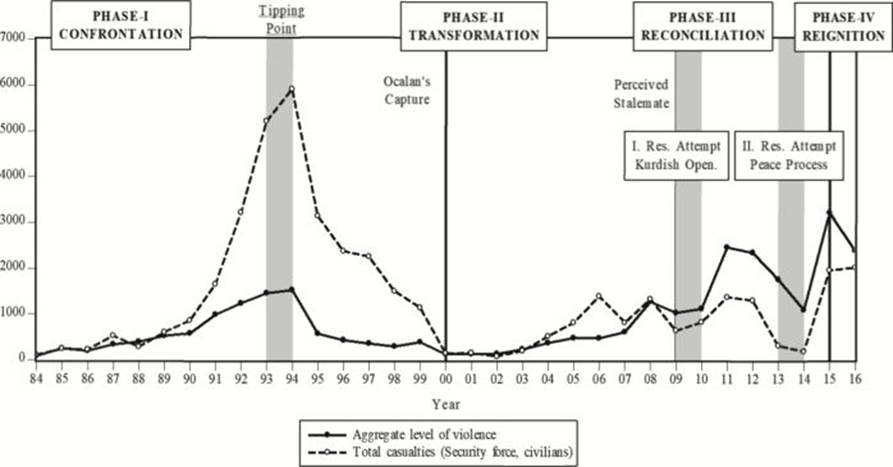
Source: Created by the authors.
Figure 3. Number of aggregate violent incidents resulting from PKK attacks, security force operations, and resulting casualties (civilians, security forces, and GKKs)
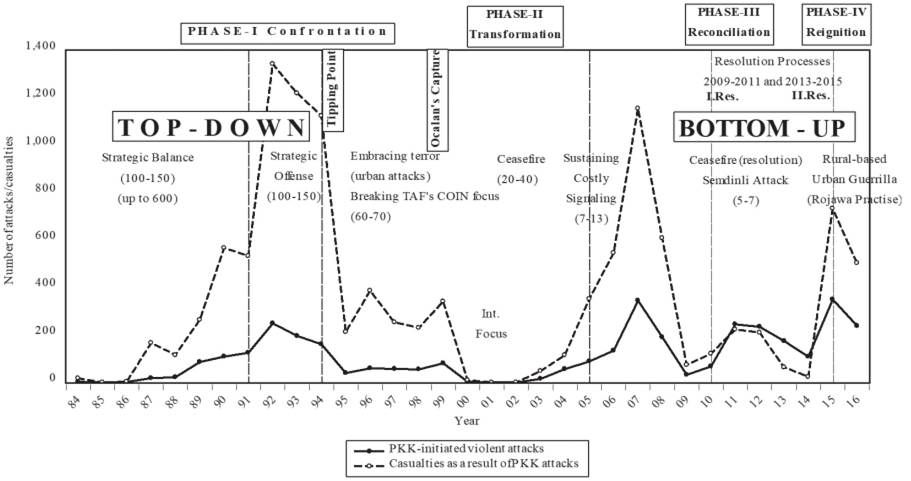
Source: created by the authors.
Figure 4. Number of PKK-initiated violent incidents and resulting casualties (tivilians, security forces, and GKKs)
The PKK-initiated violence level started decreasing in early 1992 (Figure 4). Meanwhile, the aggregate (MOP and PKK attacks results) violence level (Figure 3) continued its increasing trend until 1994, indicating a lagged effect of the change in the time and space initiative on the battlefield in favor of the TAF due to its strategic military shift in 1992.
The PKK experienced significant losses in its guerilla workforce as a result of the cordon-and-search approach and large-scale MOPs. As plotted in Figure 5, the number of incapacitated PKK militants increased disproportionately until the end of this phase. Between 1991 and 1994 alone, approximately 8,000 PKK militants were incapacitated (approximately 3,000 more were either injured or captured).
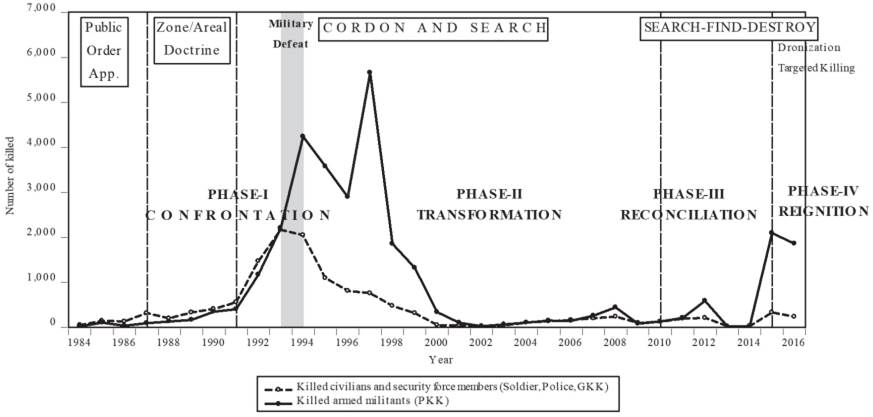
Source: Created by the authors.
Figure 5. Killed PKK militants (use of force) versus civilian and security casualties by the PKK
Öcalan acknowledged the PKK’s military defeat, stating in one of his public statements in the pro-PKK periodical Serxwebun’s April 1994 Volume that the PKK would need at least 50,000 guerillas to reach an insurgent victory in the region, where, at the time, the organization had between 8,000 and 11,000. Moreover, in this very same volume of the Serxwebun, he was quoted as saying that “in 1994, there could either be a political or military solution” (Serxwebun 1994, p. 1). With this statement, Öcalan acknowledged military defeat, implying that the PKK’s unilateral means at the time were insufficient to challenge the State s authority directly and, for the first time, referred to a political solution. So, 1994 marked the tipping point for the conflict, denoting the insurgents military defeat.
Following its military defeat, the PKK adjusted its military strategy. This adjustment triggered a transition from conventional-style fighting and guerilla tactics to terrorist attacks to preserve the organizations existence. In contrast to earlier years, these attacks no longer focused solely on the southeastern region but on all of Turkey. The characteristics of the violence changed dramatically, from heavy attacks on army outposts in the southeastern and southern regions to bombings, assassinations, and suicide attacks in Turkeys western cities. For instance, the PKK’s Marching towards the North movement sent its first group to the Black Sea region in 1994. To identify the PKK’s deviation from the Maoist model. Figure 6 plots the geographical locations of attacks in the southern and southeastern regions (emergency rule areas) versus other regions. Figures 7, 8, and 9 show the number of PKK attacks in rural vs. urban areas and the trend of bombings versus armed attacks, and the Number of PKK-initiated violent attacks targeting tourist locations, respectively.
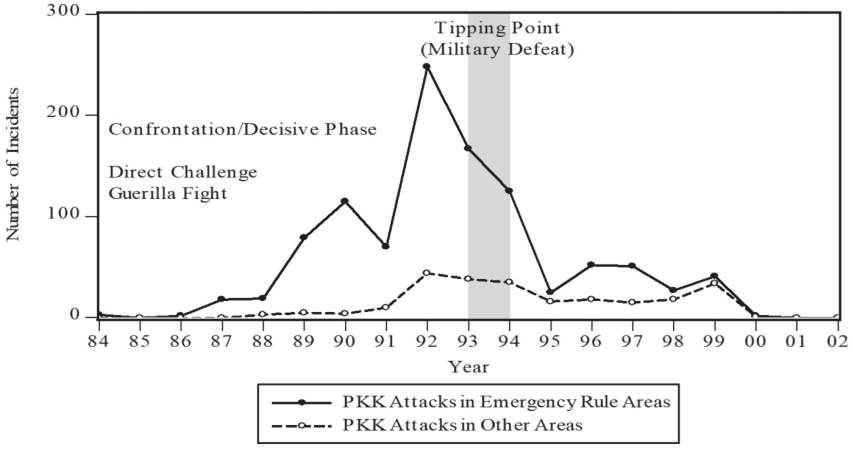
Source: Created by the authors.
Figure 6. Location of violent incidents, emergency rule provinces (Southeastern provinces) vs. non-emergency rule provinces (1984-2002).
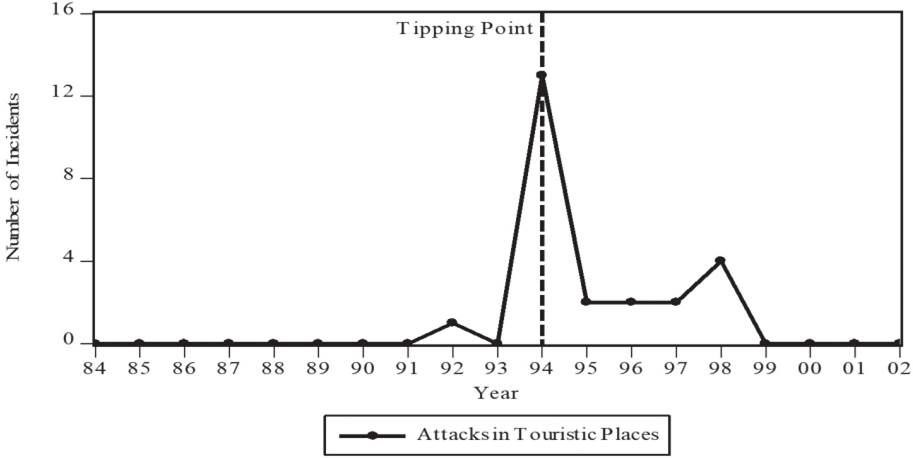
Source: Created by the authors.
Figure 9. Number of PKK-initiated violent attacks targeting tourist locations.
As shown in Figure 6, after 1994, the PKK’s attacks in emergency rule and non-emergency rule areas sloped toward each other, indicating a proportionate increase in western cities.
Meanwhile, as indicated in Figure 7, the PKK’s urban attacks displayed a proportionate increase and almost converged with rural guerilla-style attacks after the conflict s tipping point in 1994.
Similarly, bombings, as a more convenient incident type in urban terror, proportionately increased and sloped toward armed assaults (guerilla-style attacks), as shown in Figure 8. These indicate a shift from directly challenging the TAF in the key region to indirectly coercing Ankara into a political compromise by targeting civilians in urban areas. The underlying logic here was to show that Ankara was incapable of protecting its own citizens.
The PKK also resorted to typical terrorist attacks. For example, as shown in Figure 9, it started conducting attacks in western metropolitan tourist areas against civilians to damage Turkeys international image, triggering a travel ban to Turkey.
The TAF, however, did not react to this shift. Instead, it continued its previous military deterrence approach during this period (1994-1999). Meanwhile, the government employed coercive diplomacy on Syria for its prolonged support for the PKK. To strengthen the “diplomacy,” the TAF deployed troops to the Syrian border. As a result, Damascus backed down and signed an agreement with Ankara called the Adam Agreement, pledging to cease all aid to the PKK and expelling Ocalan (Ünal, 2012a). These actions enabled the TAF to capture the PKK leader in the Kenyan capital of Nairobi in 1999 and bring him to Turkey. Öcalan’s capture concluded the first phase of the conflict.
Analysis of Phase I (1984-2000)
The epicenter of the conflict during the confrontation period of Phase I was in the military domain, focusing on territorial control of the key region (See Table 4).
Table 4. PHASE I conflict parties end-state(s), grand strategies, and military strategies/doctrines overview
Source: Created by the authors.
The main theatre of operations was mostly confined to the southeastern region- particularly between 1984-1994. In contrast to the earlier described hierarchical relationship between strategy and policy, the conflict parties’ military strategies dictated their respective political objectives. This situation led to a malfunction of the strategy bridge. Objectives such as physical extermination-the quest for a decisive battlefield victory- never materialized.
The PKK’s goal of creating a separate Kurdistan was pursued mainly through a military approach aimed at achieving complete territorial control of the southern and southeastern region by expelling the Turkish authorities from the region. Given his firm belief in the PKKs military victory and to gain political traction, Öcalan did not affiliate with any newly emerged pro-PKK political parties in the early 1990s (Ünal, 2012b). The political dimension was, therefore, neglected, as was the strategy bridge. In retrospect, the ambitious political objective could not be achieved by military means only. From the PKK’s perspective, the shortfall was its inability to mobilize enough regional Kurd supporters. This failure resulted from the overemphasis on military means, as well as the misunderstanding of local socio-political structures. Despite the PKK’s armed intimidation and retributions against non-compliant Kurds in the region, it could not mobilize enough support for its cause. Moreover, it was unable to stage a revolution emanating from rural areas, given that only one-third of Turkeys Kurds supported the PKK (Ünal, 2012b). Ankara successfully exploited this strategic error through the use of the GKK. Only in the mid-1990s did the PKK shift its message from socialism to ethnicity to accommodate the Kurdish segments nationalist and religious character. The aim was to target the heterogonous structure among Turkeys Kurds to increase the popular support base. It was this shift that helped the PKK continue its armed struggle.
During this phase, Ankara committed strategic errors, too. At the beginning of this phase, the government underestimated and misunderstood its adversary, failing to take military action until 1987. This inaction in the military domain was misaligned with the political objective of exterminating the PKK (see Table 4); only from 1987 did the PKK’s extermination become the primary objective. On the grand strategic level, this was pursued through aggressive measures, including emergency laws, the GKK, forced evacuations in remote villages, and the denial of Kurdish identity at that time, and supported by heavy military action on the military strategic level.
However, once deployed, the TAF was unprepared for protracted warfare. Its use of zone control (from 1987 and 1992) hindered it from developing an efficient counter-strategy until 1992, among those strategies by Clausewitz and Tzu (Mahnken 6c Maiolo, 2014). Hence, despite the military superiority, the military tool was not used. Once Ankara started using it, it was not integrated into the broader grand strategic framework until 1992, a turning point in Ankara’s understanding of the adversary’s nature. This action did not yield the desired result until 1992, when the TAF shifted to cordon-and- search, militarily defeating the PKK. However, Turkey’s grand strategic approach involving the GKK helped impede the PKK from carrying out the Maoist approach. During this phase, Ankara failed to establish a working strategy bridge until 1992; however, once it happened, this strategic alignment yielded the necessary results. It should be noted that Ankara’s success here was also indebted to PKK’s strategic mistakes.
Phase II (2000-2009) Transformation: More politics, less military
Öcalan’s capture in 1999 had a profound impact on the PKK. From prison, Öcalan implored the PKK to end the armed struggle, suggesting a shift to non-violent political means. Following the plea in 1999, the PKK declared a unilateral cease-fire, withdrawing its fighters from Turkey. However, the Turkish government did not respond to this move and killed 300-500 PKK militants during the withdrawal. It would have been highly naive to assume the PKK’s earnestness in ending the armed struggle, given its unrelenting persistence. Rather, this was a pragmatic move to guarantee Öcalans survival.10
Following Öcalans call, the PKK transformed itself by reiterating its most prolonged unilateral cease-fire in its 7th Congress in 2000. It abolished itself twice, founding the Congress for Freedom and Democracy in Kurdistan (KADEK) in its 8th Congress in 2002, and renaming itself the Kurdistan Peoples Congress (KONGRA-GEL) in 2003. Thus, officially embracing non-violent means to acquire international legitimacy in pursuit of its current political goal to achieve constitutional recognition of Kurds in Turkey. Between 2000 and 2004, the PKK focused on gaining political recognition as a legitimate representative of the Kurds in the international arena by accelerating its front activities in Europe. To supplement its political activities abroad, the organization conducted mass demonstrations in Turkey, as depicted in the increased level of non-violent pro-PKK public events between 2000 and 2003 (Figure 10).
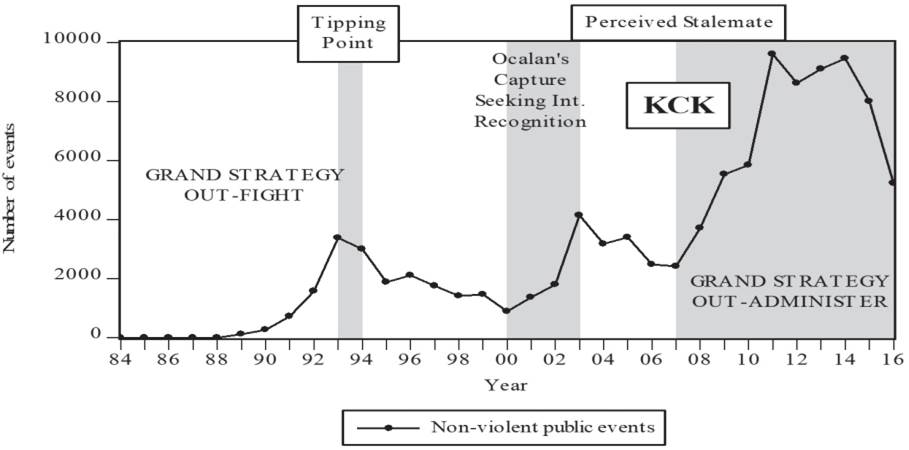
Source: Created by the authors.
Figure 10. Level of non-violent pro-PKK public/civil disobedience events
The new PKK adopted a new grand strategy, placing international pressure on the Turkish government to reach a political compromise. Ankara started feeling this pressure from 2002 onwards. Despite Ankara’s diplomatic efforts, numerous countries, including the United States, Canada, Australia, and the European Union (EU) recognized the new PKK as a terrorist organization in 2002. The PKK’s frustration resulted in resorting to old practices, namely, the use of violence from mid-2003, as depicted in Figures 3 and 4. By 2005, the organization officially declared its recreation during the 11th Congress.
During this period, although its official end-state (extermination of the PKK) and expected outcome in the conflict remained the same, Ankara started recognizing the existing grievances in the social, economic, and political contexts. The States long-standing enemy-centric approach started to morph into a population-centric approach; Ankara started implementing social and political reforms to address these challenges (Miron, 2019a; 2019b). Although annihilation defined Ankara’s military approach -the TAF as the key means for reducing the PKK surge- the government implemented responsive/ accommodative measures at the grand strategic level to address and possibly mitigate certain grievances, legitimate in its perception. These included ending the emergency rule, stopping village evacuations, enacting the “Return Home” project (enabling the displaced populations return to the evacuated areas), and lifting bans on using the Kurdish language.
The PKK expanded its goal from seeking constitutional recognition of Kurds to pursuing power-sharing, also known as democratic autonomy (Democratic Confederalism), a form of self-determination within a decentralized administrative system. This condition would grant locally-elected Mayors particular political authority. Moreover, the PKK had specific demands, such as teaching Kurdish in elementary schools, house arrest for Öcalan, and abolishing the GKK.
In line with its new grand strategy, the PKK initiated a transformation process between 2005 and 2007 from a primarily military structure to a more political one, using violence in a more complementary sense to its political campaign. In 2007, it founded the Kurdistan Communities Union (KCK), a transnational political umbrella organization, serving as the general assembly to pursue a pro-PKK political agenda and carry out a de facto application of autonomy in the region. This agenda included the creation of the Academy of Politics to increase ethnic consciousness and enact Kurdish language classes in elementary schools. All legal and illegal PKK functions and affiliated groups operated under the Kurdistan Communities Union (KCK) and Assembly of Turkey (TM) auspice, as the KCK covered pro-PKK activities not only in Turkey but also in Iraq, Iran, and Syria. With the KCK, the PKK switched to a new grand strategy of out-administering, using a bottom-up approach in contrast to its out-fighting approach during the confrontation phase. The insurgents switched to socio-political activities to achieve Öcalans desired end-state (Democratic Confederalism) through KCK events. This shift resulted in gains in the socio-political arena in which the PKK widened its support base through more social engagement by embracing different societal segments to boost Kurdish activism inside Turkey and abroad (Romano, 2012).
The PKK embraced a more asymmetric approach in its military strategy. As opposed to conventional and semi-conventional tactics using large numbers of guerrillas, the PKK reduced its mobile groups from 100-150 in the first phase to approximately 60-70 fighters after 2000 (see Figure 11). After 2007, this figure decreased to some 7-13 and sometimes even 5-7. When the PKK transformed its Army, the Liberation Army of Kurdistan (ARGK in Kurdish) into the Heza Parastina Gel (Peoples Defense Forces - HPG) in 2001, the units were further downsized to favor increased mobility and secrecy. In the conflict’ early years, the Turkish Army reduced the PKK’s overall guerilla workforce from 11,000- 13,000 to 5,000-7,000 in the 2000s.
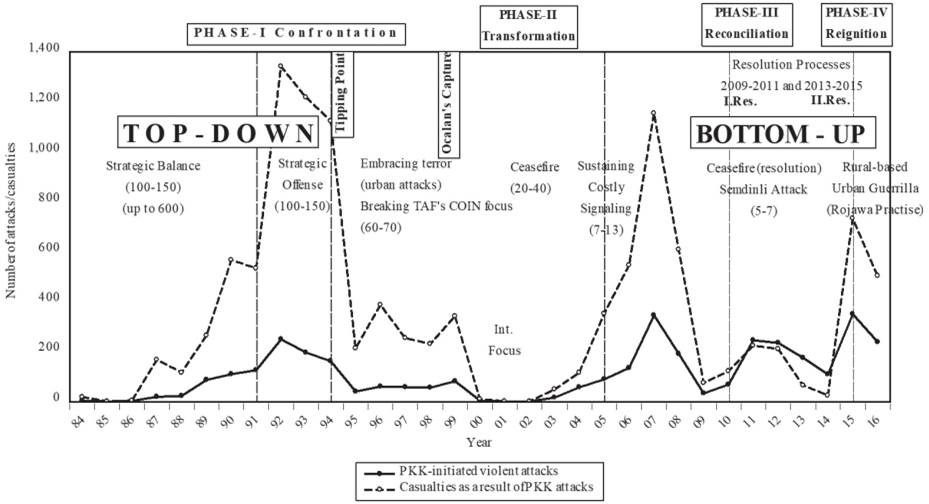
Source: created by the authors.
Figure 11. Preliminary depiction of the PKK’s response in military strategies and tactics throughout the conflict
However, this reduction did not decrease PKK-initiated violence. Its shift to increased asymmetry and terrorist attacks required far fewer fighters with a much lower risk of detection, making the PKK resilient to conducting attacks that hurt security perception. In this context, in 2007, Ankara recognized that eradicating the PKK with sole military means was not viable (Ünal & Cafhik Uludag, 2019; 2020). Thus, it changed its previous political end-state to terminate the PKK conflict using non-violent means, namely, conflict resolution approaches. This plan, however, remained only in the rhetoric. Between 2006-2007, a series of backchannel talks with the incarcerated PKK leader took place. Presumably, in 2008 (no exact date known). State delegates -comprised of the political leadership in Europe and military leadership from Qandil/Northern Iraq- met with a PKK delegation in Oslo, Norway.
Analysis of Phase II
Phase II was marked by the PKK’s strategic limbo and successive strategic shift, transforming itself into a political organization and shifting to a predominantly non-military approach. Its political objectives also changed several times: from secession to constitutional recognition between 2000 and 2005 and, after that, to democratic autonomy, showing the insurgents recognition that non-military measures were more suitable to win international sympathy for its cause.
In stark contrast with the PKK’s practices during Phase I, its military instrument took on a supplemental role. Furthermore, after failing to obtain international recognition, the PKK shifted to a bottom-up approach, mainly through the use of the KCK (2007). Its military objective was to reinforce its political campaign via “costly signaling” (Kydd & Walter, 2006) to coerce Ankara into a negotiated settlement through terrorist attacks. The aim was to remain at the forefront of the government’s agenda, seeking a negotiated settlement. In military terms, the insurgent shifted from attrition to moral exhaustion of the TAF and the State itself, targeting Ankara’s will to fight by conducting large-scale terrorist attacks in rural and urban areas (Ünal, 2016a; Ünal and Cafnik Uludag 2019; 2020). Overall, after several setbacks, the PKK managed to establish a strategy bridge, adapting to its present situation. During this phase, the organization applied the lessons learned from Phase I, recognizing that its political objective could be pursued not only by military means but also -and perhaps more importantly- by non-kinetic measures.
The PKK’s strategic shift successfully thwarted Ankara’s efforts to eradicate the organization. While the State gradually applied population-centric measures to address some Kurdish grievances in the second phase, it did not adapt to PKK’s new strategy. It also failed to fully comprehend the essence of the insurgent’s modus operandi, relying instead on annihilation in strategic military terms. The TAF, for instance, did not make any significant changes to its military strategy, which, despite its success in 1992, was outdated and insufficient to cope with the insurgent. Here, the alignment of the political objective and the military strategy -the strategy bridge- was missing, in the case of Ankara. The static nature of Ankara’s approach failed to meet the new realities of the socio-political climate. What Ankara refused to understand was that the PKK’s use of terror was a “method of action” used as part of its strategy, not a “logic of action.” In other words, it was a stand-alone strategy that divorced it from its key population, as conceptualized by Thomas Marks (2005), who also emphasizes the distinction between defensive and offensive insurgency in terms of the required use of military force, its scale, and form. Not unlike during the 1990s, in the end, Turkey was unable to establish a working strategy bridge. A greater challenge would be maintaining a functioning bridge, which implies a constant reassessment of the adversary and its strategies and a readjustment of one’s own approach.
The overview of the conflict parties’ strategies and political objectives is presented in Table 5.
Table 5. PHASE II: Summary of political objectives and measures at the grand and military strategic levels
Source: Created by the authors.
Phase III - Reconciliation (2009-2015): Resolution attempts and failures
During this phase, the Turkish government employed two consecutive resolution attempts: the Kurdish Opening of 2009-2011 and the National Fraternity/Brotherhood Project or peace process or peace process 2012-2015. Both attempts failed due to many reasons beyond this study’s scope. However, it is worth noting that Ankara’s conflict resolution process was a unilateral effort in the context of conflict management11, not a reciprocal and legally sound conflict resolution approach. For instance, its progressive efforts to address grievances and employ peaceful rhetoric were undermined by the arrest of numerous Kurdish civilians, including lawyers, activists, and civil society members, as well as 53 members of the pro-PKK political party, Democratic Society Party (DTP), based on organic ties with the KCK. In addition, more than 400 individuals were arrested in 2009, with the waves of KCK arrests continuing for the next four years.
Regional dynamics, too, complicated Ankara’s endeavors. Developments in the broader Middle East, including the Arab Uprisings (late 2010) and, notably, the Syrian Civil War (2012), led to unstable conditions that were highly conducive to power shifts in the region (Plakoudas, 2018; Ünal, 2016a). The Syrian Kurdish Democratic Union Party (PYD), known as the Syrian PKK with a pro-PKK agenda, gained de facto autonomy in northern Syria (bordering Turkey), as well as legitimacy in the international arena due to its support in the struggle against the Islamic State (IS) in Iraq and Syria. Allowing the PYD to control and rule that territory was considered risky, as Ankara had strictly objected to the creation of a Kurdish Government in Northern Iraq, and the PKK had never been able to control any territory. The rise of the IS and the increasing political instability in Iraq also increased the potential for a heightened threat level and new role(s) for regional actors, including the PKK. Ankara reconsidered its stance on the Kurdish issue domestically and abroad, including its relations with the Kurdistan Regional Government (KRG) in northern Iraq, which was ruled by the Kurdistan Democratic Party (PDK). While the regional power shifts placed more pressure on the Turkish government to resolve the conflict, they also undermined the conflict resolution process (Gürcan and Ünal 2018).
Militarily, the PKK declared ceasefires in both resolution attempts, but in between, in 2012, it increased its attacks. In August 2013, the PKK announced its “4th Fighting Strategy,” which emphasized the significance of urban-based movements (serhildan), carried out by pro-PKK civilian activists (Serxwebun 2013, p.1). As depicted in Figure 10, pro-PKK public events increased during this period. This strategy was declared as follows:
[U]p until now, we have pursued a rural-based insurgency. This approach has made us invincible and kept our resistance firm, but it has not allowed us to achieve final victory. So, it is high time to transform our struggle strategy from a rural one into an urban one. (Serxwebun 2013, p.16-17).
For its part, the TAF, shifted starting in 2009 and consolidating in 2011 from large-scale to small-scale military operations with fewer and more professional military units underpinned by SIGINT (Signals Intelligence), IMINT (Image intelligence) through unmanned aerial vehicles (UAVs), and HUMINT (Human Intelligence). A new operational concept replaced the cordon-and-search approach: search-find-destroy with more rapid deployment via air cavalry operations with a higher response rate for targeted killings. The TAF s military strategies throughout the conflict are summarized in Table 6.
Table 6. TAF’s military strategies
Source: Created by the authors.
In turn, Figure 12 shows the ratio between the number of casualties and the number of aggregate levels of violent incidents.
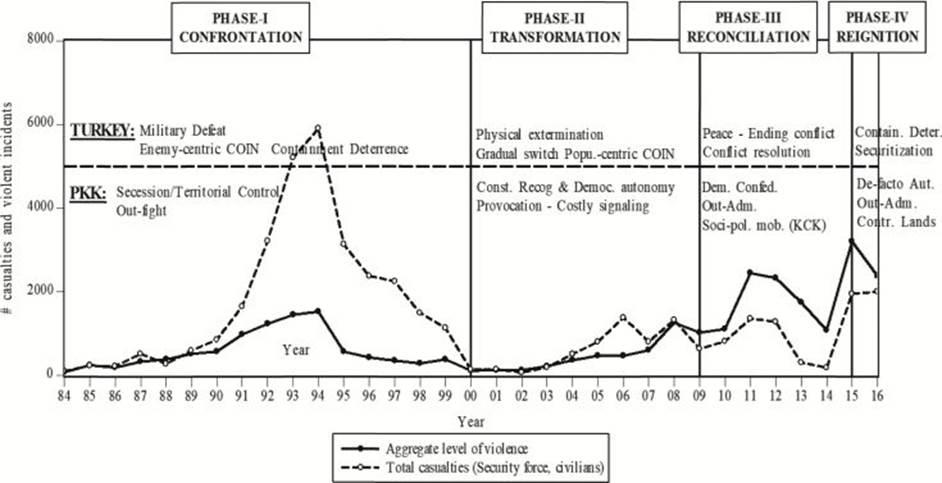
Source: Created by the authors.
Figure 12. Aggregate number of violent incidents and casualties (civilian and security) due to PKK attacks.
As shown, the trend of violent incidents versus casualties dramatically changed, intersecting in 2008 and heading in opposite directions. While, the number of incidents was lower in the early years of intense fighting, it was the opposite when the violence was used for costly signaling, starting from 2000. This occurred because the PKK’s workforce was dramatically reduced, forcing it to operate in smaller, more mobile units.
The PKKs latter attempt to control territory took place in 2012. It came to be known as the “Semdinli insurrection,” a real test of the TAF s new military strategy and its operational effectiveness. The PKK transferred groups from Northern Iraq along with heavy military equipment (e.g., anti-aircraft flaks) for a well-planned operation to gain territorial control in rural areas of the Semdinli district of the Hakkari Province (near the border with the Iraqi Kurdistan). However, the TAF’s high-tech counteroffensive frustrated this attempt (Ünal, 2016d). As a force multiplier, the TAF used permanent UAV surveillance, target designation on the ground by Special Forces units, and high-precision strikes with laser-guided air-to-surface munitions. Moreover, there was better coordination among the Army, Gendarmerie, Special Force Command, and Air Force. After this failure in rural areas, the PKK increased its terrorist attacks using its underground cells, namely, the Kurdistan Freedom Hawks (TAK). It also conducted several terrorist attacks, targeting civilians and security forces in urban areas of Turkeys western provinces (Ünal, 2016c).
Analysis of Phase III
In the third phase, the PKK’s military strategy of costly signaling (sensational and symbolic attacks) was aligned with its objective of establishing Democratic Confederalism by coercing Ankara into a negotiated settlement. At the same time, KCK-conducted public events in the socio-political arena supplemented the PKK’s broader political campaign. As a result, the PKK successfully established a functioning strategy bridge, although its attacks undermined the resolution processes and alienated a portion of the public. However, this trade-off paid off in political terms.
Ankara, though, was not as successful at establishing a working strategy bridge. Its attempt to resolve the conflict was often contradictory. On the political and grand strategic levels, for instance, the Government insisted on the PKK’s decommission despite the absence of a legal infrastructure ensuring the rest of the resolution process. This issue became clear when the PKK stopped the withdrawal after 20% of its workforce had left Turkey. Meanwhile, Ankara refrained from granting the PKK any legitimacy as a negotiating partner, making its conflict resolution efforts unilateral. In addition, the arrest of public activists and KCK affiliates highly undermined its efforts to win hearts and minds.
Furthermore, while well suited to counter the PKK’s new strategy, the military strategy underpinned by search-find-destroy operations was unaligned with the political rhetoric of conflict resolution, as demonstrated during the Semdinli incident described earlier. This new strategic military shift that took almost a decade (1999-2009) to be enacted shows that Ankara’s response, in grand and military strategic terms, was extremely delayed, failing to adapt promptly to the conflicts changing dynamics. Given the mismatch between the ends and the means, the State could not achieve the desired outcome. Table 7 presents the summary of the conflict parties’ strategies and end-states.
Table 7. Overview of political objectives and grand and military strategies during PHASE III
Source: Created by the authors.
Phase IV - Reignition (2015 - onwards): Regionalization and internationalization
Once the second resolution process abruptly ended in mid-July 2015, Ankara returned to its extermination efforts and its anti-PKK state discourses, resulting in rising tensions and a return to violence between the two conflicting parties (see Figures 3 and 4). Inspired by the title of Duran Kalkans book, the PKK introduced a new military strategy called “rural-based urban guerilla warfare.” The PKK started to employ lessons learned from its Syrian PYD branch’s “urban warfare” experience against the IS in Rojava-a territory in Northern Syria. The PKK dug ditches and built barricades as part of their overall approach to “self-governance” in Kurdish-populated towns (e.g., Şırnak-Cizre, Diyarbakir-Sur and Silvan, Mardin-Nusaybin, and Hakkari-Yiiksekova) in the south. During this phase of the conflict (shaded area), there was an evident trend toward urbanization of insurgent violence, as plotted in Figure 13, in which the dashed line denotes attacks in rural areas exceeding attacks in urban areas. The social and economic ramifications of this new wave of violence were far-reaching, affecting more than 1.3 million people in 18 urban centers and towns in Turkeys Kurdish-dominated southeastern region (Gürcan, 2015b).
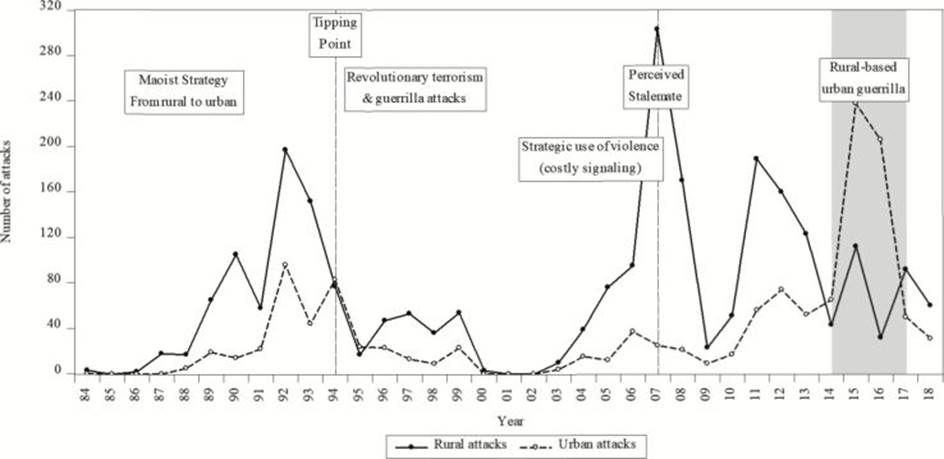
Source: Created by the authors.
Figure 13. Number of PKK-initiated attacks in rural versus urban areas (1984-2018)
Several factors differentiate the post-2015 violence from that of the 1990s, including fighting in urban centers, the involvement of PKK youth militias, and the increased influence of regional dynamics. Nearly 80% of total civilian losses were in urban centers or within their vicinity in the nine months between July 2015-April 2016 (Gürcan 2015b). Unlike in the 1990s, during this phase, the distinction between insurgents and civilian sympathizers was less distinct due to the partaking of youth sympathizers in conflicts. In addition, the PKK’s command structure changed from a highly hierarchical to a vertical structure, enabling different cells to operate autonomously (Gürcan, 2016). In the end, PKICs new strategy brought about a high death toll. From mid-July 2015 and March 2016, for instance, TAF casualties reached 355 (265 soldiers, 133 police, and 7 GKKs), while 285 civilians lost their lives (civilian casualties include attacks by the Islamic State).12 Government officials claimed that 3,583 PKK members were incapacitated, while another 602 were captured and 574 surrendered in one year (until June 17, 2016) (Milliyet, 2016). According to the International Crisis Groups (ICC) open-source database, the figure for incapacitated PKK members from July 20, 2015 to July 04, 2018 was 2,150, the number of civilian casualties was 452, and the number of security force casualties was 1,092 (International Crisis Group, 2016).
Thus, the PKK failed in its rural-based urban strategy; armed militants were either incapacitated or expelled from those towns at the expense of those towns’ physical destruction. Faced with this failure, the PKK stopped its urban terrorism and focused on the role that the PYD -its Syrian branch- had been playing. Moreover, the conflict became more regionalized and internationalized due to the ongoing Syrian Civil War (2011). Thus, Ankara’s counteroffensive efforts had to be expanded to Northern Syria and Northern Iraq. For instance, Ankara conducted cross-border ops to weaken the PYD, the PKK’s Syrian branch, which was almost in control of the Syrian-Turkish border, with the potential of spilling over into Turkey and giving the PKK the ability to regroup and recover and recruit more fighters (Ünal & Cafnik Uludag 2020).
Operationally, Turkey’s drone surge against the PKK has turned into a campaign of targeted killings of high-profile PKK leaders both inside Turkey and abroad. Turkish UAVs have seriously disrupted the PKK’s ability to mobilize and for them to keep their resilience. The TAF’s new military strategy along with armed drones with SAT-COM capabilities, extending the operational range, increasing SIGINT and more coordinated (C4ISR) along with increased collaboration among different security branches (e.g., TAF, Ministry of Interior, National Intelligence Agency [MIT]) to effectively deliver HUMINT for real-time intelligence that is crucial for executing this strategy. The PKK responded to the TAF’s move by using vehicle-borne improvised explosive devices (VBIED) and, in particular, suicide VBIEDs, exploiting the poor physical defenses of security outposts in Turkey’s rural southeast.
Analysis of Phase IV
In this phase, the PKK’s strategy bridge fell apart. Its grand strategy-a bottom-up approach defined by socio-political measures-was disconnected from its new military strategy, urban-based rural guerilla. This situation led to the PKK’s failure to control the local Kurdish population in the key region. Therefore, the insurgent started relying on its Syrian branch, the PYD. The PYD’s territory in Northern Syria was an important asset for the PKK, given that the latter has never been able to hold territory. Overall, the PKK had no choice but to shift focus from Turkey to Northern Syria in the hope of recovering from its strategic defeat.
Ankara, however, slowly managed to establish a link between its grand strategy aimed at countering the KCK agenda in the broader Middle East (Turkey, Iraq, Syria, and Iran) and its military approach (in Turkey and beyond). Lately, Ankara has been employing effect-based counteroffensives to counter the fulfilment of the KCK agenda in the northern parts of its neighbors, Iraq and Syria. These counteroffensives were reinforced by the decapitation approach to limit the PKK’s mobility. Rephrased, after several decades, Ankara managed to get the upper hand in creating a strategy bridge while also benefitting from the PKK’s strategic mistakes. The overview of conflict parties’ end-states and strategies is depicted in Table 8.
Table 8. Overview of political objectives and grand and military strategies during PHASE IV
Conclusion
This study has focused on Turkey and the PKK’s strategic interaction, analyzing the actors’ political objectives and grand and military strategies that reflected crucial shifts during the four-decade conflict. Firstly, this analysis helped identify different phases of the conflict marked by the mentioned shifts and the overall context, namely, characteristics of used violence, goal, ideology, and geography. The phases identified here were confrontation, transformation, reconciliation, and reignition. Secondly, by tracing the strategic interaction, it was possible to inquire at which stages there was an alignment between the political objectives of the actors in question and their grand and military strategic approaches pursued, that is, the presence of a strategy bridge.
Overall, both actors have crucial failures and successes in aligning their political objectives with their capabilities. The Turkish State, for instance, misdiagnosed the PKK problem from the very onset. This shortfall created a serious disconnect between the TAF’s military strategy and Ankara’s political end-state. The Turkish State would, however, benefit from the PKK’s mistakes to gain strategic advantage or apply its military response in a more acquisitive way to convert military success into political results rather than punitive. The PKK, on the other hand, made critical mistakes by rendering its means as ends, failing to align its balance between military and political stance in its prolonged endeavor.
In the first phase, for instance, the conflicting parties’ military branches clashed more directly. Thus, the parties’ military actions for territorial control of the key region dominated the first phase, and their military strategies dictated their respective political objectives causing means to become ends and leading the quest for a decisive battlefield victory. However, as subsequent phases proved, it never materialized. Ankara failed at bridging its military strategy to its grand strategy and political goal until the 1991-92 period. The government of Ankara won the battle on the field after employing a third shift: in its counterinsurgency doctrine (cordon-and-search with land aviation units). However, this PKK military defeat did not translate into political success for the Turkish State in 1994, nor in 1999, when Ocalan acknowledged the defeat or when Ocalan was captured. Turkey later bitterly experienced that this was not enough to eradicate the PKK, nor was it the start for its full demise.
The PKK also failed in its strategic military goal of creating a separate Kurdistan through a grand strategy of a top-down approach. The PKK was rather inflexible in its strategic approach during the first decade. Following Mao, its approach remained rigid without considering its counterpart’s actions. This strategic rigidity, which led to the PKK’s military defeat, was coupled with the lack of necessary popular support, given the PKK’s misconception of the local socio-political structures, thus, the population it sought to recruit. The PKK could not obtain sufficient social mobilization from regional Kurds due to the feudal structure and heterogeneous characteristics of these Kurdish areas. This condition became evident in Ankara’s successful use of the GKK as a strategy, albeit also causing Turkey many problems. Despite the PKK’s armed intimidation and reprisals against the non-compliant Kurds in the region, it could not mobilize enough support for its cause; neither was it able to stage a revolution that would emanate from rural areas.
Moreover, the PKK transformed itself and shifted to a predominantly political approach, where it modified its end-state twice with KADEK and KONGRA-GEL (from secession to constitutional recognition between 2000 and 2005 and, after that, to democratic autonomy). In that, the PKK shifted to a bottom-up approach. Its military objective became reinforcing its political campaign via costly signaling to coerce Ankara into a negotiated settlement through terrorist attacks targeting Ankara’s will to fight rather than its capacity to do so. However, Ankara failed to comprehend the essence of PKK’s modus operandi fully and continued rigidly applying annihilation in strategic military terms. What is more, the TAF’s military strategy, once successful in the 1992-99 period, was outdated and became insufficient to affect the PKK strategically, which had shifted to smaller, flexible units. The PKK’s costly signaling strategy yielded the desired results, leading to a hurting stalemate and forcing Ankara to initiate backchannel talks with the PKK. Ankara switched to a more conciliatory approach in 2007 and employed two consecutive resolution attempts. However, these attempts clearly failed due to Ankara’s misconception and mismanagement. First, Ankara addressed it more like unilateral conflict management than a reciprocated conflict resolution effort, in which Ankara- like most other states facing intrastate conflict- strictly refrained from rendering any legitimacy to the PKK as a negotiating partner. Hence, Ankara engaged in many actions that made its resolution effort inconsistent, including the arrest of political and public activists, insisting on the PKKs decommission before offering any reassurance of a legal infrastructure to conduct the rest of the resolution process, and so forth.
In later phases, the static nature of Ankara’s approach failed to meet the new realities of the socio-political climate. Once the latter resolution attempt fractured in Phase IV, violence reignited more steeply, and parties engaged in hard-core battle again, albeit in a different sphere and character. The PKK employed a new military concept called urban-based rural guerilla. However, the TAF harshly quelled its new military strategy, and casualty levels for both sides spiked. Finally, however, the PKK focused heavily on the socio-political sphere and became a more politico and less military organization led by its new umbrella organization, the KCK, covering the pro-PKK agenda in the broader Middle Eastern Region (Syria, Iraq, and Iran). Upon its failure in Turkey, the PKK started giving more weight to the PYD’s international role and its de-facto quasi-state structure by controlling certain territories in Northern Syria. Turkey responded with effective military operations. Ankara’s strategic military and political objectives of countering the KCK agenda in the broader Middle East (Turkey, Iraq, Syria, and Iran) suggested alignment, particularly in its military counteroffensives in N. Iraq and N. Syria, generally aligned with Ankara’s foreign policy-albeit volatile and inconsistent-denying pro-PKK agenda in the region. Furthermore, the TAF limited the PKK’s mobility in and out of Turkey. It decapitated major PKK figures via a new military strategy, drone-supported actions, and increased hi-tech capabilities as part of its CT approach.
In summary, the intensity of the conflict has had a volatile stance. However, the strategic interaction between the two actors has continued, with the Turkish State often lagging when it came to responding to the PKK’s strategic shifts. The PKK recognized that its military capabilities were far inferior and thus shifted its strategy to political campaigning -albeit with limited degrees of success- and supplementary terrorist activities. Ankara, again, was very slow to counter PKK’s new strategy. Only in the fourth phase did Ankara manage to create a functioning strategy bridge, aligning its means, military and otherwise, to its overall political objective. However, it is still too early to tell whether or not Ankara will be successful at beating the PKK in this strategic game despite Turkeys current and very effective UAV strategy.
Overall, the main difficulty for both actors during the conflict has been establishing a functioning strategy bridge; that is, aligning the ends, the ways, and the means and maintaining it. Static approaches that worked only in a specific context have plagued both actors. As shown, often, a strategy bridge has been absent altogether, allowing each conflict party to somewhat benefit from their adversary’s strategic mistakes. In several instances, neither party could maintain a working strategy bridge (for instance, during Phase III).
To conclude, the authors argue that the conflict will continue unless one of the parties can create and maintain a working strategy bridge for a prolonged period. In the end, Turkey and the PKK have had some successes and failures in bridging different strategy levels and political end-states. However, bridging a strategic military, grand strategy, and political end-state is a vital issue in a states’ struggles against violent non-state actors to reaching their viable overarching goal.













